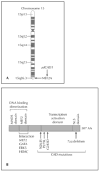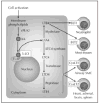Advances in the genetic basis of coronary artery disease
- PMID: 15811259
- PMCID: PMC1783687
- DOI: 10.1007/s11883-005-0012-6
Advances in the genetic basis of coronary artery disease
Abstract
Exciting advances have been made recently in genetic studies of coronary artery disease (CAD), myocardial infarction (MI), and ischemic stroke. One disease-causing gene for CAD and MI has been identified as MEF2A, which is located on chromosome 15q26.3 and encodes a transcriptional factor with a high level of expression in coronary endothelium. Approximately 1% to 2% of CAD patients may carry an MEF2A mutation. Four new susceptibility genes have been identified using genome-wide association studies or genome-wide linkage studies: LTA (encoding cytokine lymphotoxin-alpha) on 6p21.3 for MI; LGALS2 (encoding galectin-2, an LTA-interacting protein) on 22q12-q13 for MI; ALOX5AP (encoding 5-lipoxygenase activating protein involved in synthesizing potent pro-inflammatory leukotrienes) on 13q12-13 for MI and stroke; and PDE4D (encoding phosphodiesterase 4D) on 5q12 for ischemic stroke. These studies identify a new mechanism, the myocyte enhancer factor 2 (MEF2) signaling pathway of vascular endothelium, for the pathogenesis of CAD, and also confirm the role of inflammation in the disease process.
Figures


Similar articles
-
Molecular genetics of coronary artery disease.Curr Opin Cardiol. 2005 May;20(3):182-8. doi: 10.1097/01.hco.0000160373.77190.f1. Curr Opin Cardiol. 2005. PMID: 15861005 Free PMC article. Review.
-
Mutation of MEF2A in an inherited disorder with features of coronary artery disease.Science. 2003 Nov 28;302(5650):1578-81. doi: 10.1126/science.1088477. Science. 2003. PMID: 14645853 Free PMC article.
-
Transcription factor MEF2A mutations in patients with coronary artery disease.Hum Mol Genet. 2004 Dec 15;13(24):3181-8. doi: 10.1093/hmg/ddh329. Epub 2004 Oct 20. Hum Mol Genet. 2004. PMID: 15496429 Free PMC article.
-
MEF2A sequence variants and coronary artery disease: a change of heart?J Clin Invest. 2005 Apr;115(4):831-3. doi: 10.1172/JCI24715. J Clin Invest. 2005. PMID: 15841171 Free PMC article.
-
Coronary artery disease and the MEF2A transcription factor.Sci Aging Knowledge Environ. 2003 Dec 3;2003(48):pe33. doi: 10.1126/sageke.2003.48.pe33. Sci Aging Knowledge Environ. 2003. PMID: 14657507 Review.
Cited by
-
Comparative study of gene expression profiles rooted in acute myocardial infarction and ischemic/reperfusion rat models.Am J Cardiovasc Dis. 2020 Jun 15;10(2):84-100. eCollection 2020. Am J Cardiovasc Dis. 2020. PMID: 32685266 Free PMC article.
-
Genetics of the acute coronary syndrome.Ann Transl Med. 2016 May;4(10):192. doi: 10.21037/atm.2016.02.12. Ann Transl Med. 2016. PMID: 27294088 Free PMC article. Review.
-
Association between four SNPs on chromosome 9p21 and myocardial infarction is replicated in an Italian population.J Hum Genet. 2008;53(2):144-150. doi: 10.1007/s10038-007-0230-6. Epub 2007 Dec 8. J Hum Genet. 2008. PMID: 18066490
-
Inflammation as a risk factor for stroke in atrial fibrillation: data from a microarray data analysis.J Int Med Res. 2020 May;48(5):300060520921671. doi: 10.1177/0300060520921671. J Int Med Res. 2020. PMID: 32367757 Free PMC article.
-
Genome-wide linkage scan identifies two novel genetic loci for coronary artery disease: in GeneQuest families.PLoS One. 2014 Dec 8;9(12):e113935. doi: 10.1371/journal.pone.0113935. eCollection 2014. PLoS One. 2014. PMID: 25485937 Free PMC article.
References
-
- Okrainec K, Banerjee DK, Eisenberg MJ. Coronary artery disease in the developing world. Am Heart J. 2004;148:7–15. - PubMed
-
- Wang Q, Bond M, Elston RC, Tian X. Molecular genetics. In: Topol EJ, editor. Textbook of Cardiovascular Medicine. edn 2. Philadelphia: Lippincott Williams & Wilkins; 2001. electronic chapter 97.
-
- Wang L, Fan C, Topol SE, et al. Mutation of MEF2A in an inherited disorder with features of coronary artery disease. Science. 2003;302:1578–1581. This paper reports the discovery of the first disease-causing gene (MEF2A) for CAD and MI without apparent hypercholesterolemia. MEF2A protein was also shown to be highly expressed in coronary endothelium and endothelial cells. - PMC - PubMed
-
- Lander E, Kruglyak L. Genetic dissection of complex traits: guidelines for interpreting and reporting linkage results. Nat Genet. 1995;11:241–247. - PubMed
Publication types
MeSH terms
Substances
Grants and funding
LinkOut - more resources
Full Text Sources
Other Literature Sources
Medical
Miscellaneous
